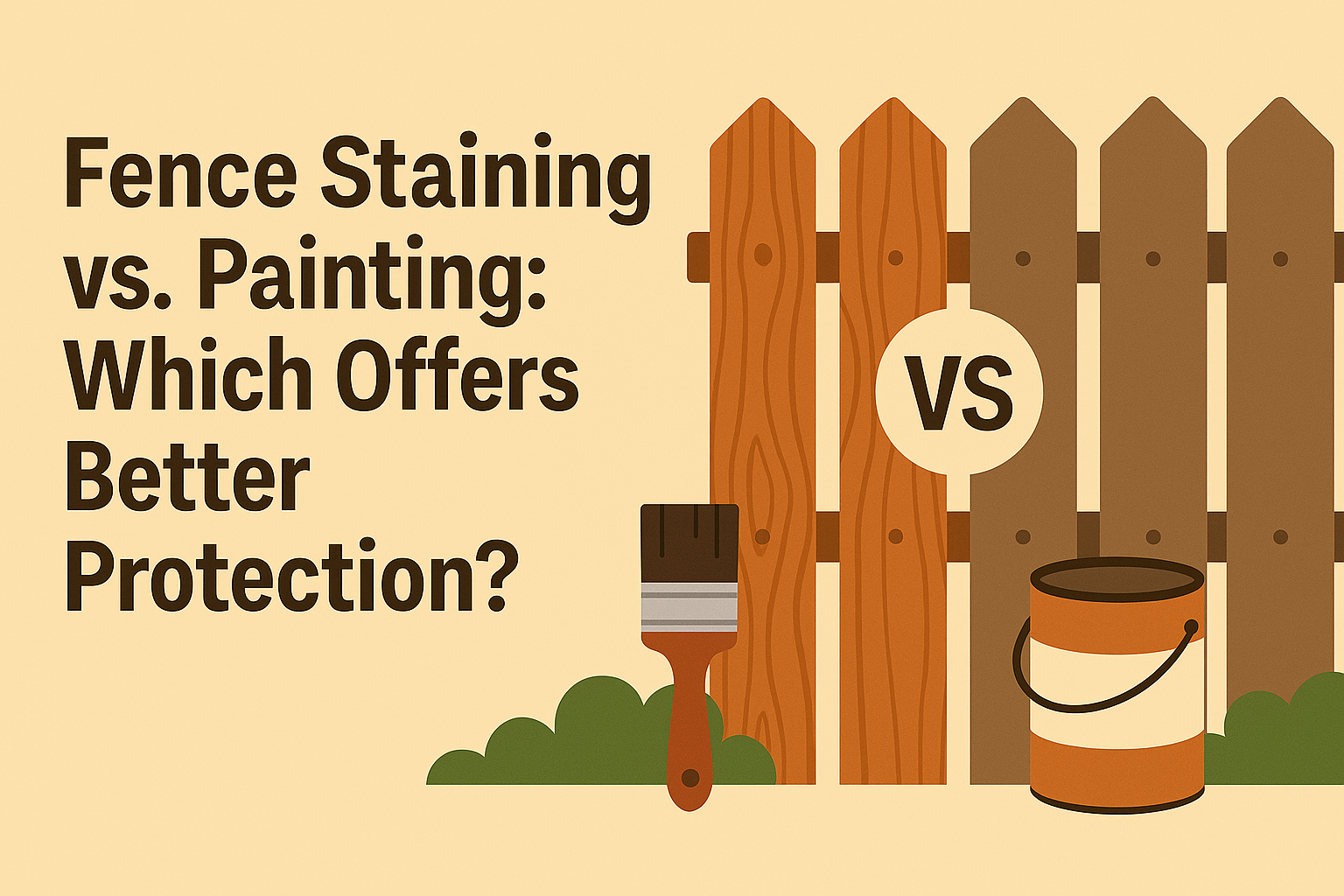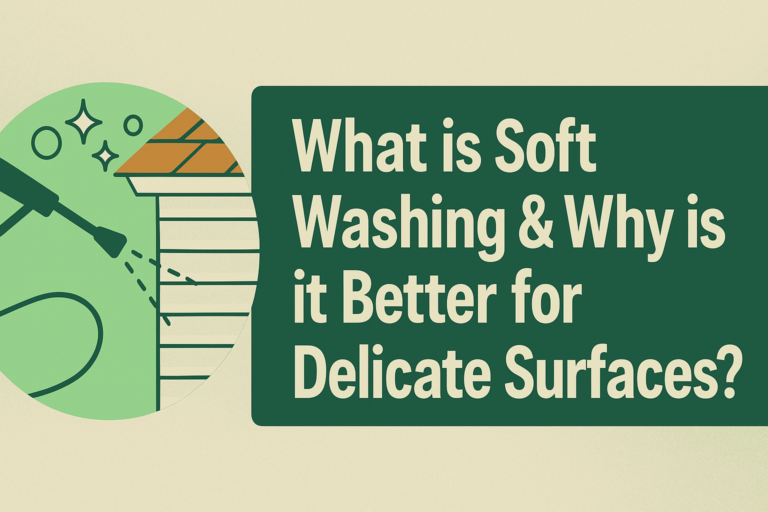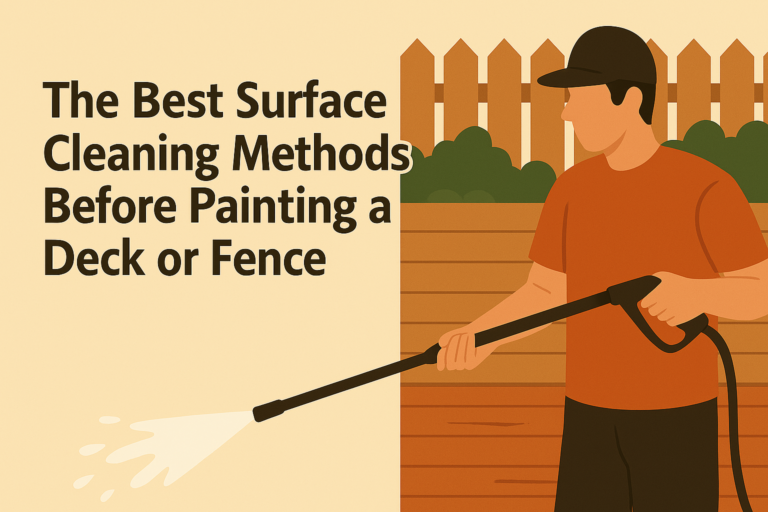Fence Staining vs. Painting: Which Offers Better Protection?
Picture this: You’ve got a wooden fence in your backyard, standing tall like the loyal protector of your property. Now, it’s time for some TLC. You’re thinking, “Should I stain or paint this beauty?” It’s a bit like deciding whether to go for a fresh haircut or try a new shade of lipstick—both options promise a transformation, but with different vibes.
Here’s the deal: Staining and painting are both fantastic ways to give your fence a makeover, but they come with their own unique sets of perks and quirks. Whether you’re in it for low maintenance or a smooth finish, it all depends on the look and protection you want for your fence.
If you’re feeling overwhelmed by the decision, it’s totally understandable. A lot goes into choosing between staining and painting your fence. And sometimes, you may want a bit of professional guidance to make sure you’re picking the best option for your needs.
That’s where professional fence staining services come in handy. They’ll help you make an informed decision and take the stress out of the process.
So, let’s break it down together and figure out which route is best for you!
Why Fence Protection Matters: Safeguarding Your Investment
Your fence is exposed to the elements 24/7, making it susceptible to wear and tear. Wooden fences, in particular, are vulnerable to moisture damage, UV rays, and extreme weather conditions like cold winters, hot summers, and heavy rainfall.
Over time, these environmental factors can cause wood to rot, warp, and lose its strength, leading to structural instability. UV rays can also cause the wood to dry out, cracking and fading its color. Without proper care, the natural beauty and durability of your fence can quickly diminish.
Furthermore, untreated wood is an ideal environment for pests, such as carpenter bees, termites, and mold, all of which can compromise the integrity of your fence. Carpenter bees, for instance, burrow into the wood to lay their eggs, weakening the structure and leading to significant damage.
Insects and fungi can also thrive in moist, untreated wood, leading to even more destruction. Neglecting fence protection means that minor issues can rapidly escalate into costly repairs or the need for an entire replacement.
Not only does this disrupt your property’s appearance and function, but it can also be a significant financial burden. That’s why it’s crucial to apply a protective finish, such as stain or paint, to your fence. A good finish creates a barrier against moisture, UV damage, and pests, preserving both the structure and aesthetic appeal of your fence.
By investing in proper fence protection, you can extend its lifespan, reduce maintenance costs, and keep your property looking its best for years to come.
Staining Your Fence: Enhancing the Natural Beauty
When you choose to stain your fence, you’re opting for a solution that preserves the natural beauty of the wood. Wood stain enhances the wood grain and gives it a rich, deep color that highlights its texture and character. This is especially true when using transparent or semi-transparent stains, which allow the natural patterns of the wood to shine through while providing protection against the elements.
- Oil-based stains are a popular choice due to their moisture-resistant properties.
- They penetrate deep into the wood, providing a long-lasting protective barrier that guards against rain, snow, and UV damage.
- Acrylic-based stains offer similar protection, while also being less likely to fade over time.
Unlike paint, which covers the wood with an opaque layer, staining allows the wood to breathe. This makes it a great option for those who want to maintain the natural appearance of wood grain and avoid a painted look.
Plus, stained fences tend to require less frequent maintenance compared to painted ones. Staining projects also often take less time to complete, and you don’t have to worry about the long drying times associated with paint.
Painting Your Fence: For a Durable, Opaque Finish
While staining provides a more natural look, painting your fence offers a completely different set of benefits.
- Paint provides a smooth, opaque finish that hides any imperfections in the wood, giving your fence a uniform and polished appearance.
- It offers a high level of UV protection, which can help prevent the wood from fading or cracking under the sun’s harsh rays.
- Unlike stain, paint forms a thick protective layer on the surface of the wood, which shields it from moisture.
This makes it an excellent choice for areas with harsh winters or high rainfall. For best results, high-quality paint options like latex paint and oil-based paints are recommended, as they offer durability and resistance to the elements.
Although painting may seem like the better option for color customization, it comes with a few drawbacks:
- The application process for paint is typically more involved than stain.
- You’ll need special equipment like paint sprayers, rollers, and brushes.
- The paint also requires adequate drying time, which can make the process longer compared to staining.
- Additionally, painted fences often require frequent maintenance as paint can chip and peel over time.
The Real Cost of Fence Staining vs. Painting: Which is More Affordable?
One of the key considerations when deciding between staining vs. painting your fence is the cost.
- At first glance, painting may seem like the more expensive option due to the need for specialized equipment like paint sprayers and brushes.
- Paint often has higher upfront material costs, especially for high-quality paint that offers better protection.
However, the overall cost of staining is generally lower. Staining projects typically require less labor and fewer materials, which reduces the overall cost.
- Oil-based stains and acrylic-based stains are relatively affordable compared to high-end latex paints.
- The cost of reapplication is another important factor. Stained fences tend to require less frequent maintenance because stain doesn’t peel like paint does.
This makes staining a more cost-effective solution in the long run, as you won’t need to reapply as often.
On the other hand, painted fences may require more frequent touch-ups due to chipping or fading, increasing the long-term cost.
Application Process: Which Option Is Easier to Apply?
The application process for staining vs. painting varies significantly.
- Staining is often faster and more straightforward, especially if you use a paint roller or handheld garden pump sprayer.
- If the wood is already rough or weathered, applying stain is an easy task, and you don’t need special preparation or equipment.
- Power washing or pressure washing may be required for cleaning rough wood before applying the stain, but overall, the process is simpler.
On the other hand, painting a fence is more complex.
- You’ll need to spend extra time on preparation, including the use of paint scrapers to remove old paint or commercial wood brighteners to treat weathered wood.
- Paint also requires adequate drying time between coats, which can extend the overall project.
If you choose to paint, you may need to invest in specialized tools like paint sprayers or rollers, which can increase the project’s complexity and cost. While these tools can speed up the process, they also require more experience to use effectively.
The Secret to Long-Term Fence Protection: Maintenance and Upkeep
When it comes to long-term protection, both painted and stained fences have their advantages.
- Staining provides a natural finish that requires less frequent maintenance.
- The moisture-resistant barrier offered by oil-based stains means the wood is less likely to rot or warp over time.
However, painted fences often require more upkeep.
- Over time, paint can begin to chip or peel, especially in areas with extreme weather.
- Frequent maintenance is needed to keep the paint layer intact and protect the fence from moisture.
- This means you’ll need to plan for reapplication every few years, depending on your climate.
For both types of protection, clear-coat finishes or commercial finishes can help extend the lifespan of the fence and reduce the frequency of maintenance.
Staining vs. Painting—Which One Should You Choose?
At the end of the day, choosing between staining vs. painting is all about what matters most to you:
- If you want low-maintenance, natural beauty, and less hassle, staining is your best bet.
- If you prefer a sophisticated look, superior UV protection, and a solid shield against the elements, painting might be more your style.
Remember, both options will protect your fence, but your decision will depend on your budget, maintenance commitment, and aesthetic preferences.
If you’re feeling overwhelmed, no need to worry! Professional fence staining services can help you make an informed decision and get your fence looking amazing with minimal effort on your part.
Conclusion
At the end of the day, staining vs. painting comes down to what you want for your fence.
- If you’re after a natural look with less maintenance, staining is your go-to.
- But if you want long-lasting protection and a smooth finish, painting might be your best bet.
And hey, if you’re unsure or just want someone to handle the heavy lifting, don’t forget about Ace Fence Staining. They’ll make sure your fence gets the right kind of treatment, so you can sit back, relax, and enjoy your yard.
So, take your pick, and give your fence the protection and beauty it deserves!







